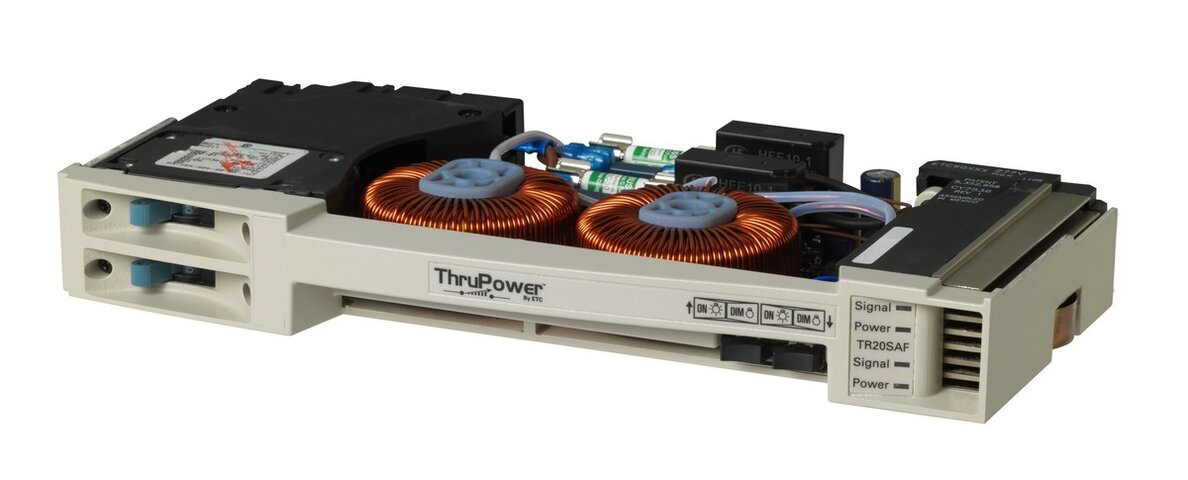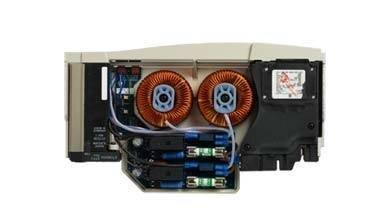Hey All,
I'm in a position at my company where I specify lighting systems for theatres. Don't Don't everyone hate at once. Everyone has a qwirk in their system that they hate, but someone has to specify the gear...
Here is my question:
Fairly new on the scene is ETC's Through Power modules for the Sensor3 racks.
TR20AF.pdf
These modules make more distinct the issue of connector types on plug strip.
While it has always been possible to utilize constant current modules to provide "wet power" (straight 120v, non dimming, in this case coming through the dimmer rack as a relay) to movers, leds, or any other items that need power, but cannot take power that has been run through the components in a dimmer. However, that was more of a 'hack' and I always was fine with telling people to just use an adaptor from their stage pin plug strip to the Edison that most of those devices need. The thought there is that someone who knows enough to pull a D20 and put on a CC module, will know to use that adaptor very carefully.
Now that the Through Power modules are on the market, and we are in this new era where all new theatres should be thinking about the eventuality that someone some day will likely want wet power in every position in a theatre: what connectors should we be putting on the plug strips, and likewise on the corresponding LEDs, moving lights, and so on. The options I currently think might work are:
All stage pin
Pros:
-utilizes the industry standard for theatre
-all fixtures have the same connector, so maintaining an inventory is easier
-easy to switch a circuit from dimmed to wet power and back
-less expense in installing plugs trips as there is no duplication.
Cons:
-Easy to accidentally dim something that shouldn't dim
Have stage pin and Edison connectors on each circuit
Pros:
-Utilizes all industry standard connectors, and all fixtures will have the 'normal' connectors on them. So conventionals will be stage pin and the movers will edison
-easy to switch a circuit from dimmed to wet power and back
Cons:
-Easy to accidentally dim something that shouldn't dim
-more expensive plug strips as each circuit has two connectors on the plug strip.
So what do you guys think / do? If you were to walk into a theatre to do a show with conventionals, movers, LEDs and through power modules; what connectors would you like to see on your plug strips and fixtures?
I'm in a position at my company where I specify lighting systems for theatres. Don't Don't everyone hate at once. Everyone has a qwirk in their system that they hate, but someone has to specify the gear...
Here is my question:
Fairly new on the scene is ETC's Through Power modules for the Sensor3 racks.
TR20AF.pdf
These modules make more distinct the issue of connector types on plug strip.
While it has always been possible to utilize constant current modules to provide "wet power" (straight 120v, non dimming, in this case coming through the dimmer rack as a relay) to movers, leds, or any other items that need power, but cannot take power that has been run through the components in a dimmer. However, that was more of a 'hack' and I always was fine with telling people to just use an adaptor from their stage pin plug strip to the Edison that most of those devices need. The thought there is that someone who knows enough to pull a D20 and put on a CC module, will know to use that adaptor very carefully.
Now that the Through Power modules are on the market, and we are in this new era where all new theatres should be thinking about the eventuality that someone some day will likely want wet power in every position in a theatre: what connectors should we be putting on the plug strips, and likewise on the corresponding LEDs, moving lights, and so on. The options I currently think might work are:
All stage pin
Pros:
-utilizes the industry standard for theatre
-all fixtures have the same connector, so maintaining an inventory is easier
-easy to switch a circuit from dimmed to wet power and back
-less expense in installing plugs trips as there is no duplication.
Cons:
-Easy to accidentally dim something that shouldn't dim
Have stage pin and Edison connectors on each circuit
Pros:
-Utilizes all industry standard connectors, and all fixtures will have the 'normal' connectors on them. So conventionals will be stage pin and the movers will edison
-easy to switch a circuit from dimmed to wet power and back
Cons:
-Easy to accidentally dim something that shouldn't dim
-more expensive plug strips as each circuit has two connectors on the plug strip.
So what do you guys think / do? If you were to walk into a theatre to do a show with conventionals, movers, LEDs and through power modules; what connectors would you like to see on your plug strips and fixtures?
Last edited by a moderator:






